| Home>Kagura>Article |
The seminar on Iwami Kagura
The following text is a slightly modified machine translation and may have some unnatural parts.
==Introduction==
I watched the online extension course "Japan heritage of Shimane: the world of myths where gods and Oni demons are moving-Kagura handed down in the Iwami area-" (November 15, 2020) by archive distribution. Lecturer is Satoru Hyoki, Professor, Faculty of Arts and Letters, Seijo University.
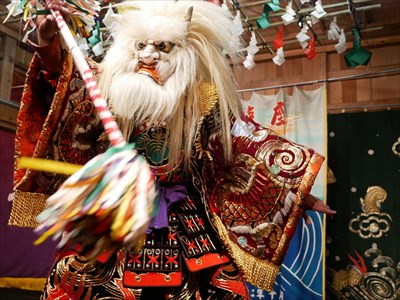
Oni demon of Jura
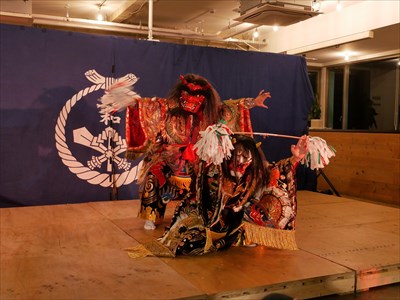
Oni demons of Jinrin
I took notes below. The presentation materials and memos (summary) are mixed and indistinguishable, but please forgive me.
==Iwami Kagura as a living tradition==
About the performance history of "Orochi" at the Osaka Expo, which triggered the breakthrough of Iwami Kagura.
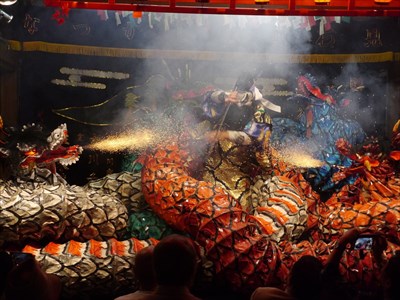
Orochi
==Japan heritage: A mythical world where gods and Oni demons are moving-Kagura handed down in the Iwami area-==
A lecture commemorating the recognition of Iwami Kagura as a Japan heritage site.
The anime "Kimetsu no Yaiba (Demon Slayer)" has become popular. Kimetsu is a world where Oni demons are moving. Iwami Kagura is also a world where gods and Oni demons move. If you would like to pay attention to the local culture. Due to the popularity of "Kimetsu no Yaiba", there are still many participants today.
About 100 people have actually seen Iwami Kagura (more than 200 people have taken online).
==What is Japan Heritage?==
* Japan Heritage
The Agency for Cultural Affairs has certified a story that tells the culture and traditions of Japan through the historical charm and characteristics of the region as "Japan Heritage".
The purpose of Japan Heritage is as follows. "The region will take the initiative in comprehensively developing and utilizing various attractive tangible and intangible cultural properties that are indispensable for telling stories. And it will strategically disseminate them not only domestically but also overseas. By doing so, it will revitalize the region. "
* What is Japan Heritage?
First certification in 2015
Iwami Kagura was certified in 2019.
While the Law for the Protection of Cultural Properties focuses on protecting and preserving the old form as much as possible, the Japan heritage is aiming at comprehensively utilizing it in the present era (revitalization of the region).
Whereas the Law for the Protection of Cultural Properties preserves individual cultural properties as points, in Japan Heritage, cultural properties are connected in a story, and they are grasped and transmitted as surface. Send to foreigners as well.
Not only Iwami Kagura but also various related heritage sites are certified together.
From point to surface. Use it as a story.
==A mythical world where gods and Oni demons move-Kagura handed down in the Iwami area-==
* Kagura
Omoto Kagura, Iwami Kagura, Ino Kagura, Arifuku Kagura, Mikazura Kagura, Kushiro Kagura, Tane Kagura, Mitani Kagura, Marumo Kagura, Hikimi Kagura, Michikawa Kagura, Tane Kagura, Takuno Children's Kagura, Tuga Nishi Kagura, Miyako Kagura, Kajio Kagura, Yukita Kagura, Zashiki Kagura, Yanagi Kagura, Nukitsuki Kagura, Kurobuchi Kagura, Shiratani Kagura, etc.
* location
Hamada City, Masuda City, Oda City, Gotsu City, Kawamoto Town, Misato Town, Onan Town, Tsuwano Town, Yoshika Town
* Tangible folk materials and crafts (articles)
Kagura wooden carved Mask, Iwami Kagura Mask (Nagahama Mask, Ichiki Mask), Nagahama doll, Sekishu Hanshi Paper, Sekishu Japanese Paper, Iwami Kagura Jado (snake body), Iwami Kagura costume (embroidery costume), Katsuji Hanshi Paper, Koshiki (steamer), Kotee (Painting made with a trowel), Yanagi Kagura Mask and costume
* Building (group)
Heroine Ohatsu's monument, Yunotsu town important traditional buildings preservation district, Omoto Kagura tradition hall, Ichiyama Hachimangu, Matsuoyama Hachimangu, Miwatani Hachimangu, Taikodani Inari Shrine, Kengyoku Shrine
* Ancient documents and books
Paper book ink book Kagura script, paper book ink book by Muneo Fujii, catalog of Ohana (charge of Kagura), year-round ritual
* Historic sites and scenic spots
Mt. Kagami, Maruyama castle ruins, Banryu-kyo (canyon)
* Natural monument
Yato Omoto Shrine's Muku Tree, Orochi Katsura, Atago Shrine's forest
* Food
Kaku sushi (box sushi / pressed sushi)
Folk materials and crafts related to Kagura, buildings, ancient documents, scenic spots, food culture, etc. Summarized as a story.
==Historical transition of Iwami Kagura==
When did it start?
Actually, I don't know. There are no historical materials from the old age
Among the various kagura in Japan, a certain type of kagura was transmitted to Iwami.
==Types of Kagura and Position of Iwami Kagura==
What is Kagura? Why do you call it "Kagura"?
* The etymology is "Kamukura". Where God is. God is on the mountain, beyond the sea, far away from the human sphere of life.
The place or thing that possesses the kami (god) is called "Kamukura"
In turn, it is an event of chinkon(Tamashizume / Tamafuri) that is held by welcoming a kami (god) to the Kamukura.
==Two Kagura==
* Mikagura
court ritual held at Kashiko-dokoro (Naishi-dokoro) in mid-December (originally the chinkon festival on the day before the Niiname-no-Matsuri festival in November of the lunar calendar) .
* Sato Kagura
A general term for kagura performed in private rituals, etc. There are kagura devoted to shrine festivals and kagura based on folk beliefs that enshrine unique kami (god) in the land and groups.
Kagura is a transliteration of "Kamukura".
Places and things that possess god (Kami).
The purpose is to chinkon (Tama-shizume, Tama-furi). The soul and human vitality decline in a certain period of time.
Regularly inspire weakened vitality and settle in the body.
A chinkon festival was held in the palace in November of the lunar calendar. Mikagura.
The shrine maiden, Sarume-kimi (descendant of Ame-no-Uzume) and others serve.
Wishing for the revival of the sun in the season near the winter solstice.
There is a private Sato (village) kagura for the Mikagura.
Kagura is performed nationwide on the day near the winter solstice. Sato Kagura as a general term.
* Types of Sato Kagura (according to Yasuji Honda's classification)
- 1. Miko Kagura (Miko Mai) Miko means shrine maiden.
- 2. Torimono Kagura
- 3. Yudate Kagura
- 4. Shishi (Lion) Kagura
Dance with various materials such as Sakaki, bells, fans, swords, and halberds in the hands.
Later, as a sideshow of the real-faced ritual dance (Shinto ritual dance), a dance with a mask (Kagura Noh) was combined with the theme of myths and tales. And generalized.
Kagura that boiled water and sprinkled
- 1. Miko Kagura: Haunts God in the cleansed body of the shrine maiden.
- 2. Torimono Kagura: Think of Torimono (Tools to hold when dancing Kagura) as Yorishiro (What God possesses). Ritual Shinto dance and Kagura Noh based on myths and tales.
- 3. Yudate Kagura: Boil water in a kettle to get steam. God will come down with that as a landmark.
- 4. Shishi Kagura: they think that god will come down to the head of an imaginary spirit beast called a Shishi (lion).
Iwami Kagura is one of the Torimono Kagura.
Isn't the Torimono a tool for the play?
Kagura Noh has come to be performed as a sideshow in addition to the real-faced ritual dance. The one that integrates them is the Torimono Kagura.
The Sada Shinno of Izumo's Sada Shrine was thought to be the source of the Torimono kagura (Izumo style kagura), but this theory is now almost denied. This is because the theory that it was organized as a result of the reforms of the Edo period became influential.
Omoto Kagura, which is handed down in Ochi county, is the source of Iwami Kagura.
Omoto god is not clear in appearance or personality, but is considered to be the fundamental god that controls all of nature.
Held every several years.
Ritual dances such as Gozamai and Kagura Noh. Gozamai means mat dance.
The ritual of Kami-gakari (god possesses) is left.
After the ritual is over, the straw snake, the incarnation of the Omoto God, is wrapped around the tree.
When the straw snake rots after a year, They think that God has returned to the original world.
Video: Playback of the Dou-no-Kuchi, Jinrin, etc. The Jinrin has a slow tempo but a Hiramai.
Kamigakari rituals are not what you would normally see in a video.
* Omoto Kagura as an "old-fashioned"
A representative example of the ancient style of Kagura in the Chugoku region, which has been handed down mainly in Ochi county, Shimane Prefecture (currently Gotsu City).
Composition consisting of a Torimono-mai dance and Kagura Noh
Performing a ceremony kagura (every 6 years) with a Kamigakari ritual to get a oracle.
* Six-tone Kagura
An old style of Kagura Noh with a gentle tempo of music.
The difference between six and eight tones is not really clearly defined.
The tempo is fast and slow in both tunes. So it's difficult to classify by that alone.
There is a theory that Kagura, which was strongly influenced by the revision of modern Kagura, is considered to be eight-tone.
==Transition of Iwami Kagura to modernization==
* Prohibition of priesthood performance (around the first year of the Meiji era)
It is not clear if the ban was actually issued under this name.
Impact of modernization: It becomes difficult for priests to dance kagura.
To peasant kagura: There is a concern that Kagura will collapse.
* Birth of eight-tone Kagura
In the 10s of the Meiji era, "Kagura revision" centered on the priesthood around Hamada City. "Voice of Kagura" script can be made.
The establishment of "enjoy watching" Kagura.
Dissemination of Kagura Noh Creates a foundation for Kagura to spread to the general public.
* Showa 29 "Edition Iwami Kagura Script" created
This is a script that is still normally available.
Bravely and brilliantly refined performance.
Iwami Kagura has the image of "Orochi", but it is not so old that Orochi became a symbol of Iwami Kagura.
==Osaka Expo that changed Iwami Kagura==
Iwami Kagura became known nationwide after the performance of "Orochi" at the Osaka Expo.
==Osaka Expo Festival Square==
* Osaka Expo
Japan World Exposition: March 15-September 13, 1970: Asia's first Expo held at Senri Hill
Unified theme "Progress and harmony of humankind"
* Festival Square as a place for entertainment → Expressing the symbol and harmony of the Expo
270,000 performers and over 10 million spectators during the session
* Events (festivals) from all over the world
"World Flower Festival," "Asia Festival," "Elephant Festival," "Children's Festival," "Old Man's Festival," "You and My Festival," etc.
Festival public relations producer: Takeo Watanabe (presided Takarazuka Revue Local Performing Arts Study Group)
He came to investigate Iwami Kagura a few years before the Expo.
Audiences who have seen the Osaka Expo: Nearly 100 people
It is a place where people from all over the world can enjoy, act, and at the same time participate and appreciate, with the spirit and character of Japanese festivals and Western plazas. (Omitted) When completed, this festival square will be a symbolic monument that expresses the theme of the Japan World Expo.
(Japan World Exposition News Separate Volume: Japan World Exposition Venue Basic Plan)
Various events were planned.
==An event called "Japanese Festival"==
The "Japanese Festival" was the main event, which was planned as the biggest attraction of the festival open space. It started in time with the national day "Japan Day" of the host country Japan. Divided into 6 series, 60 kinds of representative folk performing arts from all over the country were performed. The aim of this project was as follows. Through "the unique rhythm of the festival, which is said to be the" home of the folk heart "and the" mother of art, "and the dances and songs, costumes and tools that are typical of the festival."
Seeking Japanese aesthetic expression.]
Rediscover diversity.
In addition, let's use it as a driving force for future progress and harmony.
("Official Record of Japan World Exposition" Volume 2)
All 6 series programs. About 60 local performing arts were shown. Appeared from all 47 prefectures. The Orochi appears in the 4th series. Originally, Horan Enya of Matsue city was a candidate, but it became difficult to participate, so Iwami Kagura appeared. It was decided in October, the year before the Expo.
Japanese Festival (4)
July 28-30 19:00
Produced by: Koichi Hara
- 1. prologue
- 2. Tenjin Festival (Osaka)
- 3. Matsue no Dou Procession (Shimane)
- 4. The big ocean of Houka(Aichi)
- 5. Totsukawa Great Dance (Nara)
- 6. Iwami Kagura / Orochi extermination (Shimane)
- 7. Taiji Whale Dance (Wakayama)
- 8. Awaji Island Ship Danjiri, Tsukai Danjiri (Hyogo)
- 9. Shiraishi Dance (Okayama)
- 10. Nachi Grand Festival (Wakayama)
- 11. Katsuyama's Sagicho (Fukui)
- 12. Nihonmatsu Lantern Festival (Fukushima)
- 13. Finale
==Appeared in "Japanese Festival" by Iwami Kagura==
* Appearance of "Orochi extermination" Under the title of Orochi extermination, the performers were said to be "20 people of Iwami Kagura".
Appearance of 20 performers of Iwami Kagura
* Why "20 performers of Iwami Kagura"?
To cover the size of the venue, producer Koichi Hara came up with the idea of putting out eight large snakes.
There is no power in one-on-one Oni demon extermination at a large venue. It had to be a big snake.
At that time, there should have been almost no company with 20 members.
What "20 performers of Iwami Kagura" brought
* The number of people that cannot be covered in one company
Multiple companies perform jointly.
Adjusting acting differences
(Comparatively close company where they can practice together)
* Formation of "Hamada City Iwami Kagura company"
35 joint members from Arifuku Kagura, Kamikou companyu, and Nagasawa company (4 musicians from 3 groups each)
By the way, the Arifuku company and the Kamikou company are the former Kokubu town. It became Hamada City due to the merger the year before the Expo.
* A total of 11 large snakes
Eight + two on the Hanamichi runway + one in the scene of eating a princess. 13 according to Kamikou company
Longer than usual Jado (snake body)
A device that spits fire on the head (mouth) It was before that, but it became popular after the Expo.
Acting ingenuity
"Rolling", "Body alignment", "Large wheels (whole snakes winding)"
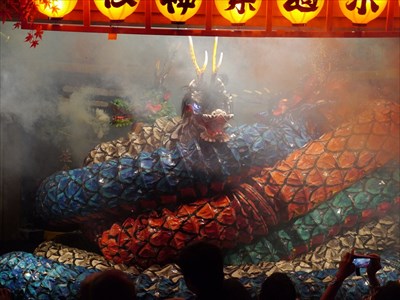
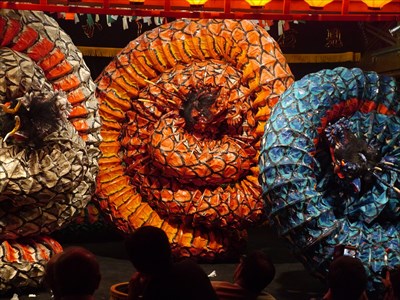

Formation of Orochi
==Iwami Kagura as a local resource==
==Iwami Kagura boom and various developments==
* Establishment and activity in the new Kagura company
* The rise of children's kagura
Kamikou Children's Kagura troupe (1972), Arifuku Children's Kagura company (1973), Sano Children's Kagura company(1975), etc.
* Establishment of Kagura competition
West Japan Kagura Tournament (Hamada City, 1971-78), Inyo Kagura Competition (Onan Town, 1976-), Inyo Selected Kagura Competition (Yoshika Town, 1976-), etc.
* As attractive performance of "Orochi"
Each company promoted the increase in the number of large snakes. Until then, there were one or two.
Specialization of Jado (snake body) production
Appearance of colorful snakes.
Establishing a Orochi (large snake) as a "representative of Iwami"
They came all the way to Iwami, so they want to see the "Orochi".
==Iwami Kagura's expansion outside the prefecture==
Due to his reputation at the Expo, they continued to appear at various events even after the Expo.
Of the three companies that appeared at the Expo, they took turns as "Hamada City Iwami Kagura Company".
The window was the Hamada City Tourism Promotion Division.
Establishment of "Hamada City of Kagura"
It was introduced on Kansai TV "Japanese Festival". They also appeared at the Takarazuka Festival.
Appearance at Yasaka Shrine at Gion Festival in Kyoto, etc.
In recent years, a permanent facility has been opened in Osaka (* currently closed due to noise problems).
The flashy and dynamic "Orochi" is easy to understand even for those who are not familiar with Kagura. Orochi became established as a representative of Iwami.
Kagura began to attract tourists from going out (business trip performances).
==Attempt to call people in Kagura==
* Iwami Tourism Promotion Council "Nostalgic Country Iwami" Tourism Campaign
From 2012
Kagura goes beyond Iwami to represent the Chugoku region.
The Ministry of Land, Infrastructure, Transport and Tourism and the Japan Tourism Agency also support Kagura.
Iwami Kagura has been certified as a Japan heritage site, but I would like you to see it from a broad perspective.
==Iwami people living with Kagura==
==Kagura and manufacturing tradition==
Collaboration with local traditional industries and crafts
* Sekishu Hanshi (Japanese Paper), an important intangible cultural property of Japan
Handmade Japanese paper technology using local raw materials (kozo, mitsumata, etc.) and clean water
* Nagahama doll
The clay mold technology for making dolls is applied to the modeling of Kagura masks made from Sekishu Japanese paper.
A large and complicated modeling mask is realized by a paper mask.
Even in Iwami, it was a wood carving mask until the Edo period.
Dynamic movement became possible with a light mask.
Creation and development in Kagura manufacturing
* Kagura costume
Katsuzo Hosokawa, the owner of the Hosokawa costume shop, trained in Shikoku, where rural Kabuki is flourishing, and made improvements to his unique technology.
The few costume stores were a node of the network of Kagura people and a base for disseminating information.
Base for publishing "Edited Iwami Kagura Script" (1954)
Before the war, Mr. Hosokawa had a history of belonging to the costume department of Shochiku (the promoter of Kabuki).
Technology that cannot be easily imitated
* Kagura Jado (snake body)
Birth of a lantern-type Jado (snake body)
Invented by Ueda (former name Hanatate) Kikuichi, a priest and kagura master in Hamada City, and his younger brother Mantaro Hanatate in the middle of the Meiji era.
Demonstration sale with brothers
Ueda Jado (Snake Body) factory
For a long time, it is almost the only Jado (snake body) factory in the whole country, and orders are exhibited not only in Kagura but also as local crafts from all over the country, mainly in the Chugoku region.
It is also used in other traditional performing arts such as Ningyo Joruri Bunraku.
A couple has worked on Jado (snake bodies) nationwide.
Kagura manufacturing and social welfare
* Kagura-related business of Iwami Welfare Association
Sano Kagura Studio / Kagura Shop Kuwa-no-Ki
They manufacture and sell kagura costumes, Jado (snake bodies), kagura masks, etc. as part of vocational training and independence support aimed at the independence of people with disabilities.
In recent years, the results have been recognized by the Kagura troupe and used.
==Kagura entrusted to the future==
Young people's approach to Kagura
As a high school club activity
Example: Nima High School Iwami Kagura Club, etc., Local Performing Arts Club
From "experience" to cultural inheritance and sustainable development
Young people who remain in the local area because they want to do Kagura
Also as a stepping stone for women to advance into Kagura. They join many Kagura troupes as a musical accompaniment.
* The rise of children's kagura
Kagura as "children's admiration"
Many children's kagura troupes were formed after the Expo.
Kagura Koshien is held every year in Hiroshima Prefecture. It is also the subject of dramas and manga.
Example: Tsuchie Children's Kagura troupe also handles overseas performances
I think that young people's kagura is important because it conveys the charm of kagura to younger children and nurtures younger children who are continuously interested in kagura for generations to come.
Traditional performing arts that are performed based on the elderly's many years of experience and knowledge may seem orthodox. However, for children, no matter how good the acting is, the one played by "Unknown bossy old man" does not look attractive. On the other hand, when the children see their older brothers and sisters working hard on performing arts, the little children look good and they want to play Kagura someday.
This kind of sustainability is achieved in the Iwami region. Wouldn't it be enviable if the successors of Kagura in other regions knew this?
At the Hamada City World Children's Museum, there is a Kagura corner where children can touch and play, and they can play by imitating Kagura by wearing costumes, but it is quite good.
(Showing the poster of the Kagura exhibition) It is not difficult, such as the genuine traditional culture of the region or the religious significance of Shinto ritual, but it is first accepted as a cool hero who confronts Oni demons and Orochi. If the children step into the world of kagura and grow up in the future, they may awaken to the deep mythical world and the depth of traditional arts and techniques.
Many traditional performing arts may have failed to broaden their horizons by raising the hurdles in order to appeal the depth from the beginning.
The activities of young people and children working on kagura in this area are interesting as they show the most basic interest in kagura among the Iwami people who live with it.
Audiences who actually want to try Kagura: About 60 people raise their hands.
==Summary: Iwami Kagura as a living tradition==
* Kagura is not limited to performing arts.
It is a culture related to local life in various aspects such as livelihood, education, and welfare.
The old ones did not change their shape and remained forever.
Reforms and ingenuity (accumulation) that match the times have led to the current prosperity of Iwami Kagura.
A culture in which the character of living tradition is often manifested
By seeing Kagura at Iwami, I want you to experience its multifaceted charm.
==Question==
Q. Why is Kagura not danced brnationwide?
A. There are many kagura in the whole country. There is also Kagura from Honshu in Hokkaido. Probably only the Nansei Islands have no Kagura.
Kagura has a lot of variations.
The Chugoku region is a mythical drama Kagura. In Kanto, there are no dances or lines. The story is not clear either. In Tohoku, Gongen Mai wears a lion head and dances. Daikagura in Ise has become an engei (entertainment). Kadozuke art. Sometaro and Somenosuke say "Congratulations" on New Year's Day, but they are Kagura masters. The image of kagura is different, and there are actually various kagura.
Q. Where does the Kagura performed have a story?
A. Although there are many in the Chugoku region, there are many kagura in other regions that are expressed in dance without dialogue. There are many things that do not exist.
Kagura is basically dance. A play called Noh stuck to it and became the current Kagura.
Q. Kagura dance is also used as a special move in "Kimetsu no Yaiba (Demon Slayer)". Is Kagura as a martial arts element realistic?
A. Probably not at all when asked if it can be used technically.
Kagura is a stylized play.
Many dances use swords symbolically.
It is used not as a weapon for fighting, but as a ritual that possesses god.
Many ancient ritual weapons have been excavated in Shimane Prefecture.
The use of swords may be strongly influenced by Yamabushi of Shugendo.
Regarding "Kimetsu no Yaiba (Demon Slayer)", the black sword "Gekka no Sasa" in the Okuizumo Tatara and Sword Museum in Okuizumo Town, Shimane Prefecture is similar to the main character's sword. Tamahagane is also in the collection.
"Oni no Shito-Iwa" of the Oni demon's tongue tremor (Oni-no-shitaburui)
Q. What role does Kagura play in modern times?
A. The Iwami region has been suffering from depopulation and aging after the war, but speaking of Iwami, it will appeal to the whole country. In recent years, Iwami has actually come to see it. Tourism resources.
There are young people who dare to stay in the local area because they want to play kagura.
It may be all about sightseeing, but I want you to take a closer look at the lives of the people around it.
==Comment from Dr. Hyoki==
Kagura is an interesting thing that you can simply see and enjoy. Rather than seeing it as an authentic (genuine) culture with historical value from the beginning, it starts with a purely childlike fun. When you get addictive, there are various depths beyond that. It is necessary to have an environment where you can easily touch Kagura in order to attract attention and broaden the base.
... Dr. Hyoki spoke fast and asked many times to put his remarks into the text.
Satoru Hyoki's "The Road Followed by the Eight Great Snakes-The Appearance of Iwami Kagura" Orochi "at the Osaka Expo and Its Impact-" is included in "Study on Creativity of Iwami Kagura" (Shimane Prefectural Ancient Culture Center, 2013). It contains the contents that He talked about in this lecture.